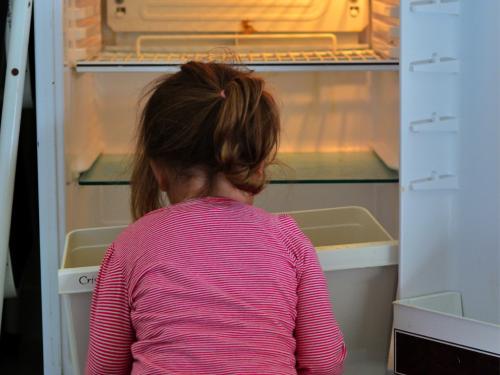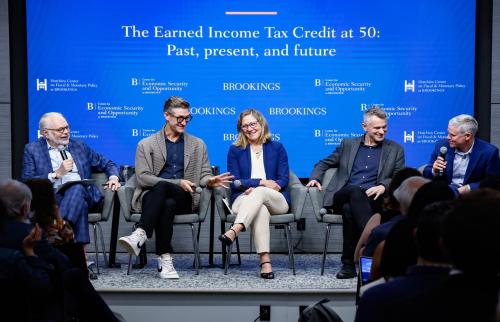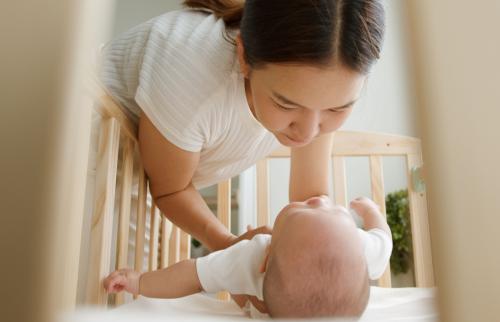In 2020, mothers of younger children were primary and primarily caregivers. In this piece, we document declines in labor force participation among mothers and provide evidence of how mothers spent their time in between May and December 2020, following the onset of the COVID-19 pandemic. We find that overall, mothers of children 12 and under spent an average of 8.6 hours per day on direct and secondary child care activities. Restricting attention to employed mothers with children 12 and under also spent about 8.3 hours (8 hours during the weekday) per day on direct and indirect child care, and worked about 6.1 hours per weekday.
Concerned with chronicling the economic security of families with children and how mothers of young children were spending their time during the COVID-19 pandemic, The Hamilton Project in partnership with the Future of the Middle Class Initiative fielded surveys of mothers with children 12 and under in April 2020 and Fall 2020 (The Survey of Mothers with Young Children [SMYC]).[i] Through this survey, we documented extraordinary levels of material hardship in families with young children and the stress and time pressures that mothers have had to manage. Today, the US Census Bureau released the American Time Use Survey diaries for May-December 2020. These data allow for a more comprehensive picture of how Americans spent their time following the onset of the COVID-19 pandemic. This much larger federal survey corroborates the findings of the SMYC: mothers with children 12 and under have spent much of the past year caregiving.
The COVID-19 pandemic has widened labor force participation gaps between mothers and fathers, and among mothers by marital status and the age of their youngest child. Figure 1 shows the extent to which labor force participation rates (LFPR; the share of a given group working or actively seeking work) have recovered to their level in January 2020. As of June 2021, the most recently available data, the LFPRs of prime-age mothers (those aged 25-54) remain well below the pre-COVID level. In recent months, LFPRs of single mothers and mothers of young children have started to rebound, while rates among mothers of elementary-school-age children and married mothers have stalled and mothers of teens have declined after an initial strong recovery. Single mothers, who typically have the highest rates of labor force participation among prime-age mothers, had the largest initial fall in LFPR and, as of June 2021, the rate remains 5 percentage points below its January 2020 rate of about 81 percent.
For The Hamilton Project, Lauren Bauer, Arin Dube, Wendy Edelberg, and Aaron Sojourner found that in states with relatively high levels of elementary school closures, the declining employment among mothers with an elementary-school-aged child was more than fully accounted for by having elementary school age children instead of teenagers; in other words, declining LFPR among mothers over the past year was caused not only by the COVID-19 recession, but also by elementary school closures.
The burden of school closures not only made working outside of the home more challenging for mothers, it added education, facilitation, and caregiving-related time pressures to every day. Before the pandemic, caregiving responsibilities fell disproportionately on women and on mothers. That has continued during the pandemic.
Figure 2 shows the average number of hours per day that mothers and fathers of children 12 and under spent providing child care (including education). We compare this to the amount of time that parents spend awake and alone (not including working), sleeping, or working (whether working alone or with others).[ii]The definition of direct child care involves activities like bathing and teaching while secondary child care involves other caregiving activities with children. Mothers spent twice as much time doing direct child care (2.1 hours versus 1 hour) and 1.6 more hours per day than fathers doing secondary child care. In total, mothers are spending about 3 hours more per day than fathers on child care.
In the May-December 2020 ATUS, as shown in figure 3, employed mothers spent 6.1 hours on average working during weekdays compared with 7.7 hours for fathers. During the weekday, working mothers did 8 hours of direct and secondary child care, less than mothers who were unemployed or not in the labor force (about 9 hours) but more than employed fathers (5.2 hours), unemployed fathers (7.5 hours), and fathers not in the labor force (4.6 hours).
For those mothers with children 12 and under who held onto their jobs over the course of 2020, how they spent their time on weekdays changed dramatically. According to Caitlyn Collins, Liana Landivar, Leah Ruppanner, and William Scarborough, during the first two months of the COVID-19 pandemic, among parents with children age 12 and under, mothers reduced their time spent working by 4 to 4.5 times more than fathers did. In the SMYC, far fewer working mothers of young children reported working fulltime hours than from 2014-19. Compared with the May through December 2019, employed mothers (and fathers) are doing over an hour more child care per day during week days.
Since the COVID-19 pandemic and its associated recession began, mothers of children 12 and under were less likely to be employed and working, more likely to be unemployed, less likely to be working full-time hours, more likely to have dropped out of the labor force, and more likely to be spending a substantial amount of time caring for children whether working or not.
The COVID-19 pandemic and recession has disrupted decades of progress for women in their labor market outcomes and potentially their career trajectories for years to come. The COVID-19 recession has intensified differences in the labor market experiences of mothers as well as differences in how mothers and fathers spend their time far beyond the employment and labor force participation margins that were tracked in real time over the past year. This piece highlights that only focusing on increasing LFPR among mothers misses a material part of the story of the past year: mothers who held onto their job struggled to balance competing demands on their time.
Mothers of elementary school age children have borne the brunt of school closures but are a small enough share of the labor force that, while a grave problem for this group, their drop in labor force participation is not holding back the recovery in a macroeconomic sense. Nevertheless, supporting mother’s reentry into the labor force and support for working mothers through actionable policy proposals is an urgent matter of public concern and threatens long-term productivity and potential GDP growth. Specifically, containing the COVID-19 pandemic, speeding a successful roll-out of vaccines to children, and ensuring that all schools, preschools, and child care facilities have the resources and guidance to open and reopen safely (with increased investment in childcare and early education as proposed by Elizabeth E. Davis and Aaron Sojourner) are necessary for children and their parents.
Update: This analysis was updated on July 26, 2021 to restrict months to May-December 2019 and May-December 2020 and to limit “alone-time” to time spent awake and alone but not working.
[i] The Survey of Mothers with Young Children (SMYC), was administered by The Hamilton Project and the Future of the Middle Class Initiative at Brookings twice, between April 27 and April 28, 2020, and between October 7 and November 5, 2020. For additional details, please see the technical appendix to “10 Economic Facts about how Mothers Spend Their Time.”
[ii] In prior work, we also provide estimates of other nonmarket labor activities, leisure/screen time, and civic engagement and will provide estimates for these set of activities for 2020 at a later date.
-
Acknowledgements and disclosures
The authors thank Michael Madowitz and Wendy Edelberg for helpful feedback, Veronica Clevenstine for excellent research assistance, and Jeanine Rees for graphic design.
The Brookings Institution is committed to quality, independence, and impact.
We are supported by a diverse array of funders. In line with our values and policies, each Brookings publication represents the sole views of its author(s).











Commentary
Time waited for no mom in 2020
July 22, 2021